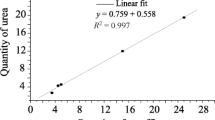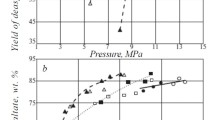Conclusions
-
1.
An investigation of the effect of the ketone concentration in mixtures of ketone and toluene on severe dewaxing of raffinates has revealed that the curves plotting the yield vs. the ketone concentration have the same character for acetone and MEK. A region of relatively slight change, and a region of sharp decrease in the yield of dewaxed lube are observed in both cases.
-
2.
Depending on the viscosity and solidification point of the lube obtained, the limiting concentrations after which a mixed fall in lube yield occurs are as follows: for acetone 35–43%, for MEK 60–70%. The advantage of MEK is that its concentration in the solution can be varied in a wider range; this makes dewaxing more flexible.
-
3.
It has been shown that the superiority of MEK over acetone under optimal dewaxing conditions is manifested in an improvement of the TED and an increase in the filtration rate, as follows: for MS-8 lubes by 3°C and 15%, for transformer oils by 5°C and 12%, respectively, and for MS-6 lubes by 2°C.
The authors recommend optimal dewaxing conditions, which give high yields of markedly dewaxed lubes (from 67.7 to 71.5%).
Similar content being viewed by others
Literature cited
Petrol si Gaze,19, No. 2. 123–129 (1968).
I. T. Alyukov, Novosti Neft. Tekhn. Ser. Neftepererabotka, No. 5 (1959).
V. M. Shkol'nikov, G. Ya. Azbil', I. B. Bronfin, I. I. Medvedovskaya, and V. P. Mikita, Novosti Neftyanoi i Gazovoi Tekhniki, Ser. Neftepererabotka i Neftekhimiya, No. 11, 9–11 (1962).
D. O. Gol'dberg, Control of Oil and Paraffin Manufacture [in Russian], Izd. Khimiya (1964), p. 56.
A. A. Chesnokov, G. G. Burmistrov, and A. M. Shevtsov, Extensive Dewaxing of Lubes [in Russian], Izd. Khimiya (1966).
Z. P. Slugina, E. V. Voznesenskaya, and N. I. Vasil'eva, Khim. i Tekhn. Topliv i Masel, No. 1 (1957).
N. I. Chernozhukov, S. É. Krein, and B. V. Losikov, Chemistry of Mineral Oils [in Russian], Gostoptekhizdat (1959), p. 203.
G. T. Dadayan, B. V. Ol'kov, and G. V. Shakhsuvarova, “Sulfur petroleums and their refining products,” Trudy BashNII NP, No. 7, 130 (1962), Izd. Khimiya.
E. V. Voznesenskaya, Z. P. Slugina, V. I. Kutukova, F. S. Yakobi, G. V. Shakhsuvarova, N. I. Vasil'eva, B. V. Gryaznov, and M. Z. Rozenshtein, “Lubricants, their additives, and paraffins,” Trudy VNII NP, No. 7, 69–78 (1958), Gostoptekhizdat.
Author information
Authors and Affiliations
Additional information
Translated from Khimiya i Tekhnologiya Topliv i Masel, No. 10, pp. 13–17, October, 1972.
Rights and permissions
About this article
Cite this article
Enikeeva, L.S., Bikkulov, A.Z. & Marintseva, A.V. Effect of the ketone concentration in the solvent on severe dewaxing of low-viscosity raffinates of sulfur petroleums. Chem Technol Fuels Oils 8, 743–746 (1972). https://doi.org/10.1007/BF00717068
Issue Date:
DOI: https://doi.org/10.1007/BF00717068




